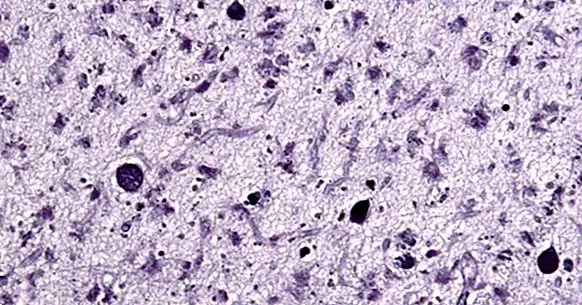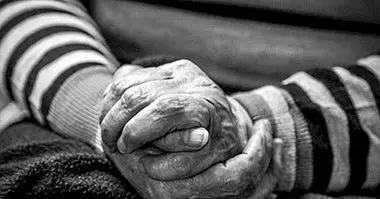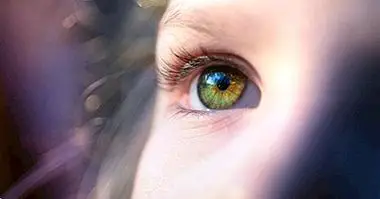Batten's disease: symptoms, causes and treatment
The number of rare diseases registered throughout the history of medicine varies between 5,000 and 7,000 different diseases or conditions, of which the vast majority has its origin in some type of genetic alteration.
One of these rare diseases with a genetic charge is Batten's disease . It is a medical condition that affects only children and their symptoms can lead to total dependence and sometimes death.
What is Batten's disease?
Batten's disease is a condition of genetic origin and of life-threatening course that affects the child's nervous system. This disease begins to appear between 5 and 10 years of age and its first symptoms are recognizable because children begin to suffer from seizures and vision problems.
Also, it is possible that they appear initially other more subtle symptoms such as changes in the child's personality and behavior , difficulties and delays in learning and awkward movements and falls when walking.
This condition was first described in 1903 by the pediatrician Frederik Batten, who gave it its current name. further it is also known as juvenile neuronal ceroid lipofuscinosis .
Main features of this disease
As mentioned earlier, Batten's disease is a genetic condition that is within the group of lysosomal storage disorders . It has very little incidence but has a very disabling symptomatology that can even lead the child to death.
Your genetic origin causes the cells of the human body to be unable to get rid of the substances and waste that circulate through it , causing an excessive agglomeration of proteins and lipids, that is to say of extracts of fatty type.
This storage of fatty substances ends up causing considerable damage to cellular structures and functions, which gradually leads to the distinctive gradual deterioration of this disease,
Likewise, the structure most affected by Batten's disease is the nervous system , the brain being the most damaged organ of the entire system.
- You may be interested: "Parts of the human brain (and functions)"
symptom
As previously mentioned, Batten's disease currently mainly affects the nervous system, therefore all the symptoms belonging to this disease will be related to the neurological area .
This symptomatology affects mainly three areas of great neurological weight: vision, cognition and motor skills, over which it exerts a progressive deterioration effect.
Next, the symptoms of each one of the affected areas will be described:
1. Progressive loss of sight
The progressive deterioration of sight is one of the first symptoms that appear in Batten's disease. This symptom, which usually makes its appearance during the first years of life, it evolves until it causes total or partial blindness of the child when he is about 10 years old.
Within this category of symptoms are included some others, also related to vision, that appear throughout the development of the disease. These symptoms include:
- Pigmentary Retinitis .
- Macular degeneration
- Optic atrophy
2. Seizures
Other symptoms that appear during the early stages of the disease are repeated convulsive episodes. These convulsive episodes are transient incidents characterized by the presence of seizures caused by abnormal or excessive neuronal activity .
Within these convulsive episodes, two different classes can be distinguished:
Focal seizures
These crises are caused by an abnormal functioning of specific areas of the brain. These crises are characterized because the person is subjected to a series of rapid movements. During the course of these crises the person may suffer loss of consciousness , and rhythmic and involuntary movements in any part of the body.
Generalized seizures
In this second type of epileptic seizures, abnormal neuronal activity affects practically all brain areas. Absence crises are part of this type of episode , or tonic and atonic seizures among many others.
- Related article: "Absence crisis: causes, symptoms and treatment"
3. Deficits in cognition
Both the agglomeration of lipid substances and the damage caused by epileptic seizures, end up causing a serious neurological deterioration, which is manifested by a loss of abilities that the child had already learned.
These cognitive deficits they can affect any area of language, memory, thinking or judgment . Also, this generation process tends to be accompanied by changes in the child's behavior, personality and mood, and may even present a psychotic episode.
4. Psychomotor problems
In Button's disease too musculoskeletal and motor functioning may be affected , coming to hinder and condition the child's mobility.
Within these psychomotor problems may occur:
- Involuntary contraction of muscles .
- Sensation of burning, numbness, itching and tingling in the upper and lower extremities.
- Hypotonia or hypertonia.
- Almost complete paralysis of the extremities .
5. Limitations and dependency
Finally, in the later stages of Batten's disease Children often have lost the ability to move and communicate , so they are in a situation of absolute dependence.
Causes
As mentioned above, Batten's disease has a genetic origin. Specifically, its origin is located in the chromosomal pair 16 which presents a series of mutations in the CLN3 gene . This gene is located in the nuclei of somatic cells.
Although the functions of this gene are not known exactly, its mutation causes an abnormal and excessive accumulation of material and fatty substances in the tissues of the nervous system.
These lipopigments cause a series of important damages in the affected cellular areas , giving rise to the distinctive progressive degradation of this condition.
Diagnosis
In the event that relatives are aware of the existence of a family history of Batten's disease, it is necessary perform a prenatal exam or evaluation using the amniocentesis test or by chorionic villus sampling.
However, if the evaluation takes place after the birth of the child, it will be necessary to carry out an exhaustive evaluation that guarantees a correct diagnosis. Typical tests performed in this evaluation are:
- Genetic studies
- Nervous tissue biopsy .
- Physical exam.
- Neurological exploration.
- Evaluation of visual capacity.
- Blood test .
- Urine analysis.
- Electroencephalography (EEG).
Treatment
For the time being and due to the particularities of Batten's disease, a protocol for action or treatment has not yet been established that can stop the symptoms or cause them to remit.
However, convulsive symptomatology can be controlled by the administration of anticonvulsant medication . Also, thanks to the benefits of physical and occupational therapy, children affected by Batten's disease can preserve the functioning of their organism as long as possible.
The stimulation of the patients and the information and the support to the families by means of groups of therapy can favor or facilitate the confrontation to this disease.
- Related article: "The 7 types of anticonvulsant drugs (antiepileptic drugs)"



















